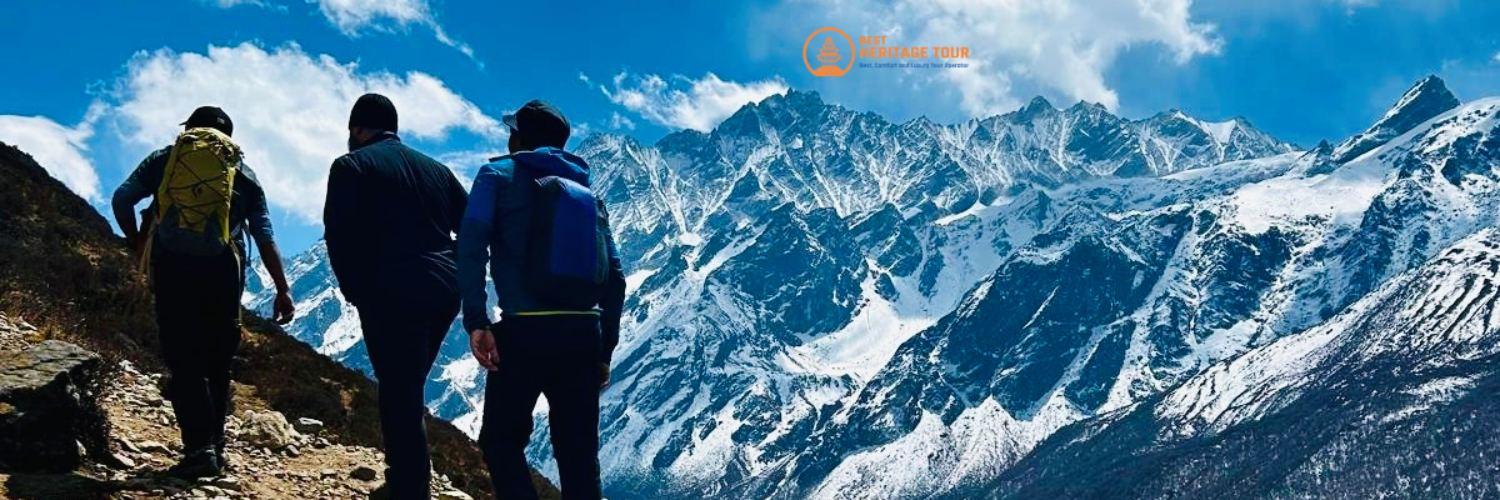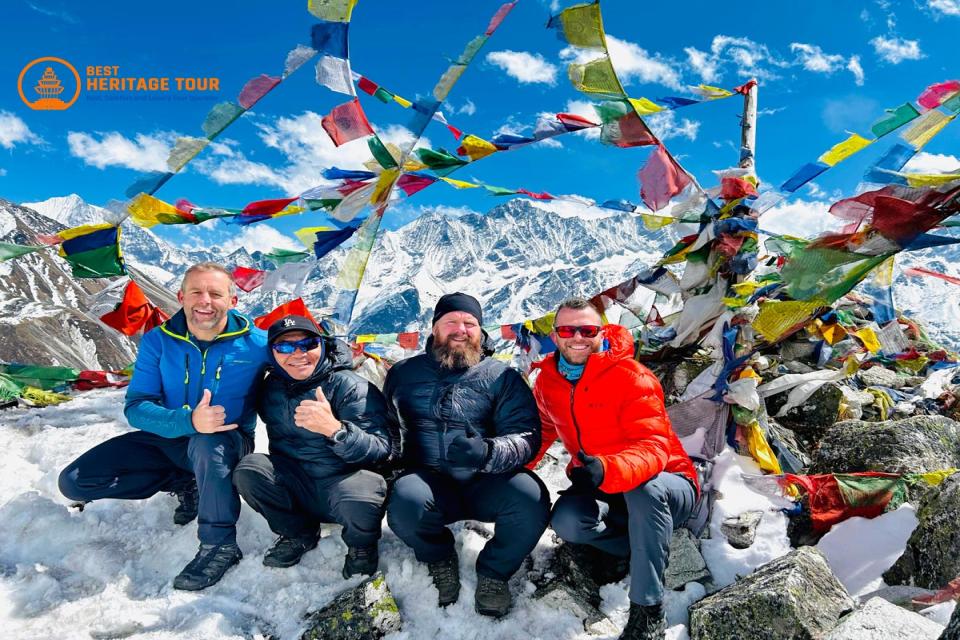Nepal’s Langtang Valley Trek is a favorite among trekkers seeking moderate trails, stunning Himalayan scenery, and a cultural experience that feels authentic yet accessible. While the trek is rewarding year-round, spring (March to May) offers a unique charm that draws adventurers from around the world.
During spring, the valley comes alive with blooming rhododendrons, lush greenery, and crystal-clear mountain vistas. The moderate weather, combined with longer daylight hours, makes spring an ideal season for trekking in Langtang. Whether you are a first-time trekker or a seasoned hiker, a spring trek provides the perfect mix of adventure, beauty, and comfort.
In this guide, we explore everything you need to know about trekking in Langtang during spring, including trail highlights, flora and fauna, weather considerations, cultural encounters, and tips for planning a safe and memorable trek.
Why Spring is the Best Season for Langtang Valley
1. Blooming Rhododendrons and Alpine Flowers
-
Langtang Valley is famous for its rhododendron forests, which blanket the hillsides in red, pink, and white during spring.
-
You can also spot primulas, magnolias, and various alpine flowers at higher elevations.
-
Photography enthusiasts and nature lovers enjoy this colorful landscape, making spring the most picturesque time to trek.
2. Mild and Pleasant Weather
-
Spring offers moderate temperatures, avoiding the extreme cold of winter or the heavy rains of monsoon season.
-
Daytime temperatures in the valley range from 15°C to 20°C, while nights are cooler but manageable with proper sleeping gear.
-
Clear skies provide excellent visibility of snow-capped peaks, including Langtang Lirung (7,227m).
3. Longer Daylight Hours
-
Daylight lasts approximately 12-13 hours, allowing trekkers to cover more distance comfortably.
-
Early morning and late afternoon hikes are safe and provide the best light for photography.
4. Ideal Trail Conditions
-
Trails are generally dry and stable in spring, reducing the risk of mudslides and slippery paths seen during monsoon.
-
Streams and rivers are flowing with melted snow, adding beauty without obstructing trekking paths.
Langtang Valley Trek Highlights in Spring
1. Syabrubesi: The Gateway
-
The trek usually starts at Syabrubesi, a picturesque village surrounded by dense forests and rivers.
-
Spring is perfect for exploring local markets and tea houses before beginning the trek.
2. Lama Hotel: Scenic Forest Trails
-
Walking through rhododendron forests, trekkers experience fragrant blossoms and occasional wildlife sightings.
-
Families and beginners find the path gentle and enjoyable.
3. Langtang Village: Cultural Immersion
-
Spring offers clear views of the valley and surrounding peaks, with traditional houses showcasing Tibetan-influenced architecture.
-
Villagers often tend their springtime crops, giving trekkers a glimpse of local life and agricultural practices.
4. Kyanjin Gompa: Monastery and Cheese Factory
-
Visit the ancient monastery with panoramic views of Langtang Lirung.
-
Try local cheese produced by the community, a treat during the trek.
-
The spring weather allows for comfortable day hikes around Kyanjin Gompa.
5. Optional Day Hike to Tserko Ri
-
For trekkers seeking a challenge, a day hike to Tserko Ri (4,984m) offers breathtaking panoramic views.
-
Spring provides stable footing and visibility, enhancing safety and photographic opportunities.
Flora and Fauna During Spring
-
Rhododendrons: Bloom abundantly between 2,000m-3,500m, creating a colorful canopy.
-
Wildlife: Himalayan Thar, barking deer, red pandas (rare), and various birds can be spotted.
-
Butterflies and Insects: Increase in number, adding vibrancy to forest trails.
-
Trekking in spring allows wildflowers and blossoms to be fully visible, unlike the dry winter months.
Spring Weather and Gear Considerations
1. Clothing
-
Layering is key: base layer, fleece, and lightweight waterproof jacket.
-
Spring days are mild, but mornings and evenings can be chilly.
-
Trekking pants, gloves, hats, and sunglasses are recommended.
2. Footwear
-
Well-fitted trekking boots and moisture-wicking socks prevent blisters and slips.
-
Optional trekking poles help maintain balance on uneven trails.
3. Sleeping Gear
-
Lightweight sleeping bags rated for -5°C to 0°C are generally sufficient in spring.
-
Insulated liners or blankets can provide extra comfort.
4. Safety Equipment
-
Sunscreen, first aid kit, water purification methods, and trekking maps are essential.
-
Guides from Best Heritage Tour ensure safety and proper acclimatization.
Cultural Experiences in Spring
-
Local Festivals: Some villages celebrate spring festivals, offering unique cultural exposure.
-
Traditional Villages: Observe stone houses, prayer flags, and monasteries with vibrant spring colors.
-
Community Interaction: Spring is planting season; trekkers may see locals working in terraced fields.
Health and Safety Tips
-
Acclimatize gradually to prevent altitude sickness, even though Langtang is moderate.
-
Drink plenty of water to stay hydrated during longer spring days.
-
Protect against sun exposure: SPF 30+ sunscreen, sunglasses, and hats are necessary.
-
Monitor children and older trekkers carefully; the mild weather reduces strain but vigilance is important.
Accommodation and Food
-
Tea houses are well-stocked during spring, offering warm meals and drinks.
-
Popular menu items include dal bhat, noodles, soups, and momo.
-
Book lodges in advance for spring, as it’s a peak trekking season.
Best Heritage Tour’s Spring Trek Services
Best Heritage Tour offers expert guidance for a comfortable and enjoyable spring trek:
-
Custom itineraries suitable for all fitness levels.
-
Experienced guides provide cultural insights and safety supervision.
-
Help with accommodation, meals, and logistical support.
-
Ensure access to clean water and first aid throughout the trek.
By planning your trek with Best Heritage Tour, trekkers can enjoy breathtaking views, vibrant flora, and authentic cultural experiences without worry.
Tips for a Memorable Spring Trek
-
Photography: Carry cameras or smartphones; spring colors and clear skies are ideal.
-
Pack Light: Moderate weather allows minimal layers, making trekking easier.
-
Early Starts: Take advantage of morning light for scenic views and wildlife sightings.
-
Interact Locally: Encourage children or family members to engage with villagers.
-
Stay Hydrated: Even in mild weather, trekking demands water and electrolyte intake.
-
Flexible Schedule: Spring weather is generally stable, but occasional rain or wind is possible.
Conclusion
The Langtang Valley Trek in spring offers the perfect blend of natural beauty, cultural experiences, and comfortable trekking conditions. Blooming rhododendrons, moderate temperatures, and scenic Himalayan vistas create an unforgettable adventure for trekkers of all levels.
For those planning a spring trek to Langtang, Best Heritage Tour provides professional guidance, safe accommodations, and cultural insights to make your journey enjoyable and hassle-free.
Phone: +977-9851149197 / +977-9810043046
Email: info@bestheritagetour.com | bestheritagetour@gmail.com
Booking/Info: www.bestheritagetour.com
Office Location: Thamel Marg, Kathmandu, Nepal
Experience the blossoming beauty of Langtang in spring, and create memories that last a lifetime!
Author: Best Heritage Tour
Date: 22nd August, 2025


